Wolves are one of the most social animals on earth, they’re right up there with us, the Great Apes, dolphins, lions, elephants, etc. Their lives are about family. Wolves may disperse from their natal packs between 1-3 years of age but it’s an individual choice. When they do decide to leave they’re prepared to do whatever it takes to find a mate and claim new territory. And that’s when the trouble begins for them.
There’s a reason wolves have been unable to reclaim lost habitat in most of their former range, they’re killed before they have a chance. The Pacific Northwest, Northern Rockies, Great Lakes and Southwest, where critically endangered Mexican gray wolves struggle to increase their numbers, are the only areas of the country where gray wolves are successfully breeding and raising pups. BUT in 2009, when wolves in the Northern Rockies were delisted by the Obama administration, their recovery took a very dark turn. Until recent court decisions relisted wolves in Wyoming and then the Great Lakes, they suffered the same fate as their wolf brothers and sisters in Montana and Idaho.
Wolves are hunted with extreme animus, tortured by leghold traps, snares, arrows, bullets, many gut shot to prolong and increase their pain. The ultimate sadism directed at wolves was legalized in Wisconsin, as a twisted form of dog/wolf fighting. It allowed the use of up to six dogs per trophy hunter to track and trail wolves. It’s not a stretch to believe some hunters let their dogs tear into the wolves, once they were cornered, delivering an even more grisly, frightening and painful death. That’s been put on hold for now, due to recent court decisions but members of Congress, pandering to agricultural and hunting interests, are already scheming to make an-end-round the courts and pass legislation similar to the 2011 budget bill delisting rider, that removed wolves in Montana and Idaho from the endangered species list.
Life is hard for wolves in this country. The dream of wolf reintroduction has turned into a nightmare for hunted wolves. Idaho’s beleaguered wolf population faces endless wolf hunts that stretch through breeding, denning and pupping season. Hunting quotas have all but been removed in most of Montana and Idaho. In the Treasure State up to a hundred wolves can be killed by a single private landowner.
The situation for hunted wolves is not a success story but a tragedy. When wolves attempt to disperse, as Echo did, they usually end up DEAD.
Another barrier to wolf recovery is Wildlife Services, a ghastly federal agency, funded by American tax dollars. They act as the Department of Agriculture’s killing arm, destroying millions of animals annually, including hundreds of wolves. It’s agriculture’s personal hit man-tag-team. Click here, here and here to read the Sac Bee’s expose of this hellacious agency.
Is it a surprise then that wolf recovery has been stopped in most of the country, outside of the areas I’ve mentioned? The odds are stacked against wolves as they face the likes of Wildlife Services, poachers, hostile state governments, hunters and ranchers. Wolves are trapped by man-made boundaries they dare not cross. Boundaries that hold no meaning for them but ultimately contribute to their deaths.
One of the deadliest threats to dispersing wolves is the “coyote excuse”. As I stated in part one, using those two words, gives the shooter a perfect alibi. It’s “he said, he said”. Or “she said, she said”. The wolf is dead, it’s the shooter’s word that counts.
What’s so striking about the wolf killings in Kentucky and Kansas is wolves had been absent from those states for decades and specifically in Kentucky, for 150 years. Instead of celebrating the return of the wolf, she’s shot dead.
The USFWS should be prosecuting these people, to send a message that killing endangered wolves IS NOT OK. Instead they let “hunters” off with the “coyote excuse”. I don’t care what the “coyote hunters” say, if they kill an endangered wolf they should be prosecuted, period! That will send a signal to these numbskulls that shooting endangered wolves has consequences. But the USFWS continues to fail wolves, they don’t take the killings seriously. It’s pretty clear USFWS is not interested in gray wolf recovery, that’s why they’re pushing for a national delisting.
And why is it OK to kill coyotes? It’s not. I’ve seen one too many horrific images of dead coyotes, killed for fun, killed for nothing. Coyotes undoubtedly need protection as well.
It’s a slap in the face to wolf and wildlife advocates that the agency charged with protecting wild wolves looks the other way when wolves are killed with impunity, meting out almost no punishment, even though the ESA clearly states:
– authorizes the assessment of civil and criminal penalties for violating the act or regulations; and
– authorizes the payment of rewards to anyone furnishing information leading to arrest and conviction of ANY violation of the act or any regulation issued there under.
A mockery has been made of the ESA concerning wolves. it’s a joke to think they’re protected, when time and again they’re killed as they attempt to disperse, just as Echo’s sad story proves.
Unless and until the American people stand up to the Interior Department and Congress, nothing will change. The system is broken and corrupt and needs a complete overhaul.
Here are a just a few examples of what happens when wild wolves dare to disperse from their natal packs, in search of a mate and new territory. It’s the wolf version of Russian Roulette.
===
UTAH
Echo shot dead by coyote hunter using “coyote excuse”.
Her death was a tragic blow to wolf recovery, being the first confirmed wolf to inhabit the Grand Canyon in 70 years.
First Gray Wolf Spotted At Grand Canyon In 70 Years Shot Dead By Hunter
BY ARI PHILLIPS POSTED ON FEBRUARY 12, 2015 AT 2:59 PM UPDATED: FEBRUARY 13, 2015 AT 8:54 AM
Officials have confirmed that the first gray wolf seen around the Grand Canyon in 70 years was killed in December by a hunter in southern Utah after he mistook it for coyote. The three-year-old female, named “Echo” through a contest held with hundreds of schoolchildren, was the first gray wolf to be spotted in the region since the 1940s. After being collared in Wyoming in early January 2014, the wolf had ventured at least 750 miles into the new territory — further evidence that gray wolf populations are coming back from the brink of extinction after decades of reckless killings.
“The fact Echo had ventured into new territory hopefully signifies that there is still additional habitat where this vulnerable species can thrive and survive,” Nidhi J. Thakar, deputy director of the public lands project at the Center for American Progress, told ThinkProgress.
The coyote hunter who shot Echo, and whose name has not been released, reported the killing to authorities as an accident. Gray wolves are on the Endangered Species Act and it is illegal to kill them anywhere in the U.S. except Idaho and Montana, eastern Washington and Oregon, and northeastern Utah. According to the Center For Biological Diversity, this partial removal of federal protections in the Northwest has lead to the deaths of thousands of wolves through state-authorized hunting and trapping in recent years. Congress is now considering a legislative rider that would preclude protecting wandering wolves like Echo, according to the wildlife conservation group.
“Echo’s killing illustrates the perils that wolves face and the imperative to maintain federal protections as called for under the science-based standards of the Endangered Species Act,” said Michael Robinson of the Center for Biological Diversity, in a statement. “Keeping wolves on the endangered list is the basis for the public education we need, to enable more wolves to live and thrive and minimize conflict.”
http://thinkprogress.org/climate/2015/02/12/3622423/famous-grand-canyon-gray-wolf-shot-by-hunter/
===
*Warning graphic images
Kentucky
Wolf shot dead using “coyote excuse”.
“In Kentucky, the first gray wolf seen in 150 years was shot dead last August….earth first newswire
Wild Wolf in Kentucky, First in 150 Years, Killed by Hunter
by Russ McSpadden / Earth First! News
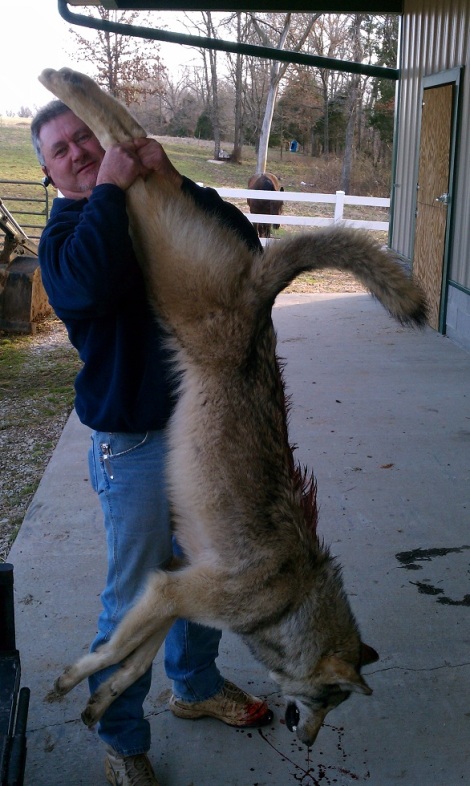
“This photo posted on KentuckyHunting.net shows the first wolf to wander Kentucky in over 150 years, dead and exhibited as a trophy”..earthfirstjournaldotorg
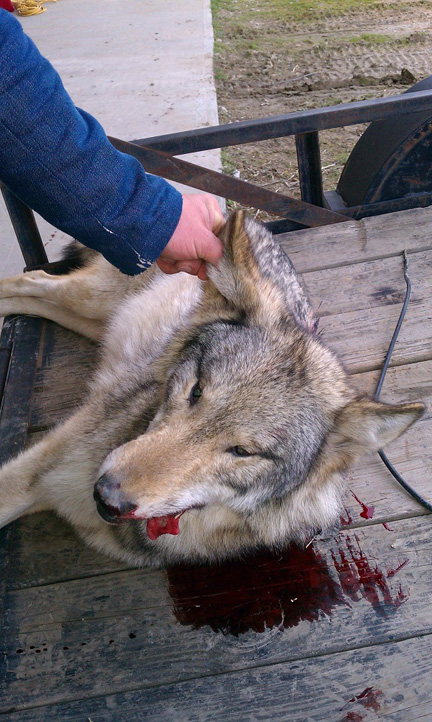 earthfirstjournaldotorg
earthfirstjournaldotorg
According to a recent announcement by state wildlife officials, a 73-pound, federally endangered female gray wolf was shot dead by a hunter in Munfordville, Kentucky earlier this year. Were it Alaska or Idaho this wouldn’t be news, but Kentucky has not seen wild roaming wolves since the mid 1800s.
“Wildlife officials identified the man who killed the wolf as Hart County resident James Troyer, who shot the animal believing it to be a coyote.”
Read More:
===
Kansas
80 pound wolf killed using the “coyote excuse”. This was the first wolf confirmed in Kansas in 108 years.
Coyote hunters kill 1st wolf in Kansas since 1905
Wolf killed in December in northwest Kan.
Published 6:00 PM CST Feb 02, 2013
TOPEKA, Kan. —Coyote hunters have killed a wolf in northwest Kansas, the first documented wolf in the state since 1905.
The Topeka Capital-Journal reports that the wolf was killed in December. The animal weighed more than 80 pounds, more than twice as much as a large coyote.
===
Missouri
Wolf killed in Missouri using the “coyote excuse”. Third gray wolf killed there in the last 13 years.
Hunter kills Gray Wolf in central Missouri
POSTED 6:17 PM, JANUARY 15, 2014, BY CHRIS SMITH, UPDATED AT 06:14PM, JANUARY 15, 2014
HOWARD COUNTY, MO. (KTVI) – This past fall a man from southeast Missouri killed what he thought was coyote on his property in Howard County, which is near Columbia, Missouri. But, after a closure inspection of the animal, he thought it was something else.
The Missouri Department of Conservation says that the man killed a Gray Wolf. This is a Federally protected species. DNA confirms the wolf is from the Great Lake states. Officials think the wolf may have wandered down from Minnesota, Wisconsin or Michigan. The animal was not tagged and is not believed to have been a captive animal.
This is the third Gray Wolf killed in Missouri over the past 13 years. Many of them were shot by hunters mistaking the wolves as coyotes.
http://fox2now.com/2014/01/15/hunter-kills-gray-wolf-in-central-missouri/
===
Colorado
Wolf Poisoned
Dispersing Mill Creek Pack female wolf poisoned by Wildlife Service’s deadly 1080 compound.
Compound 1080…. “is one of the horrific poisons Wildlife Services uses in its arsenal to kill our wildlife.”
The Amazing Journey and Sad End of Wolf 314F (UPDATE)
October 16, 2009
I posted this story in October 2009 about an amazing little Mill Creek Pack wolf, who traveled 1000 miles from her home in Montana to a lonely hillside in Colorado, called “No Name Ridge”, where her bones were found.
Her death has been under investigation by USFWS all this time.
Finally, after almost two years, it was announced she was poisoned by the deadly compound 1080. It is one of the horrific poisons Wildlife Services uses in its arsenal to kill our wildlife.
https://howlingforjustice.wordpress.com/2009/10/16/the-amazing-journey-and-sad-end-of-wolf-314f/
===
Washington
Wolf shot for existing
Whitman Co. farmer could face charges for killing wolf
Joshua Babcock Murrow News Service10:09 a.m. PST November 29, 2014
Washington fish and wildlife officials are recommending a Whitman County farmer face misdemeanor charges for shooting a gray wolf last month.
The charge could result in a year in jail and a two-year suspension of hunting, fishing and trapping licenses.
Steve Crown, chief of enforcement for Washington Department of Fish and Wildlife, said the shooter was a farmer who also notified authorities. Crown said it is unclear why the farmer shot the wolf, as it did not appear to pose an imminent danger to pets, livestock or the farmer.
Crown said this is the third wolf shooting this year in Washington.
“If it’s just in the area, it’s not open season for wolves,” Crown said.
Read more:
http://www.krem.com/story/news/local/whitman-county/2014/11/28/whitman-co-farmer-facing-charges-for-killing-gray-wolf/19641521/
===
Illinois
Wolf or Wolf hybrid hit By A Car
Wolf?! found at Morris – Probably a hybrid
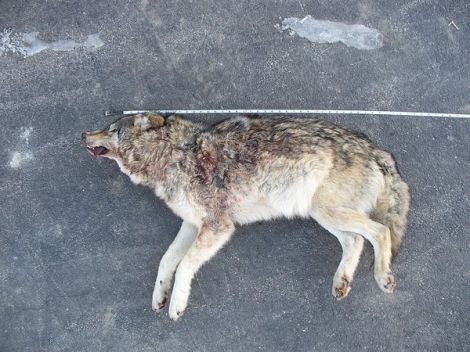
This 48-inch long, wolf-like canine was found, apparently hit by a vehicle, on Nettle School Road, just northwest of Morris on Feb. 13. Measurements have been taken determine if it matches common wolf dimensions and DNA testing may be done.
Posted: Friday, February 20, 2015 9:03 am
Robert Themer
rthemer@daily-journal.com
A large, wolf-like animal found dead on a roadside north of Morris last Friday “looks like it might be a hybrid of some sort,” says Illinois Department of Natural Resources district wildlife biologist Bob Massey.
“It has characteristics of coyote, dog and wolf,” Massey said Wednesday, after IDNR sent out a news release about the animal being found along Nettle Creek Road, north of Interstate 80, early on Feb. 13. The site was a couple miles northwest of Morris, Massey said.
The animal was found by a some guys heading to a hunt club, who then called, he said.
Massey has measured the animal and sent the information off to a wolf biologist in Wisconsin.
“If it falls within the parameters of wolf size, we will send it for DNA analysis by the U.S. Fish and Wildlife Service,” he said.
http://www.daily-journal.com/news/local/wolf-found-at-morris—probably-a-hybrid/article_c1f521e0-439e-528b-821f-096908694708.html
===
North Carolina
10 Red Wolves killed by “coyote hunters”
10 highly endangered Red wolves were “confirmed or suspected gunshot deaths since the start of last year.” Once again the “coyote excuse” was used.

Highly endangered red wolves being shot with impunity – only 100 wild red wolves left in North Carolina. Apparently these yahoos will shot any wolf they can.
Endangered red wolf shot in NC, 10 in past year
WCNC Staff, WCNC.com3:34 p.m. EST January 13, 2014
RALEIGH, N.C. (AP) — The death toll for endangered red wolves continues to mount near their North Carolina refuge.
Federal and state wildlife agencies said Monday that another red wolf was found shot to death last week in Tyrrell County. That makes 10 confirmed or suspected gunshot deaths since the start of last year.
There are only about 100 red wolves roaming an area in Tyrrell and four other northeastern North Carolina counties where the U.S. Fish and Wildlife Service has been trying to restore the animals in the wild.
The state Wildlife Resources Commission this summer allowed coyote hunting in the same five-county area, but hunters easily confuse the two animals.
A federal judge is scheduled to hear arguments next month in a lawsuit by conservation groups seeking to stop the coyote hunting.
http://www.washingtontimes.com/news/2014/jan/13/endangered-red-wolf-shot-in-nc-10-in-past-year/
===
New York
Coyote killers even shoot horses – no animal is safe!
Lousy Coyote Hunters Shoot Horses, Licences Seized
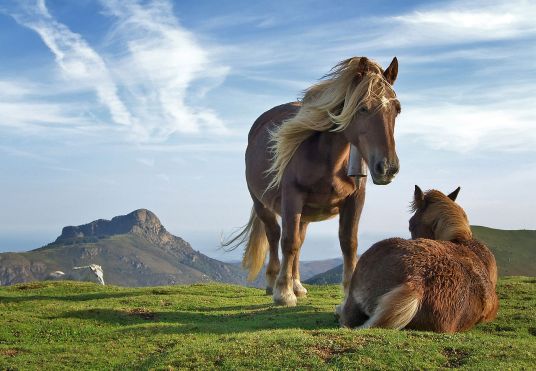 (not horses killed)
(not horses killed)
18 Feb, 2015 – CONRAD BAKER
SPARTA – The Department of Environmental Conservation (DEC) has revoked two individuals’ hunting licenses for three years and issued a monetary penalty after the hunters shot and killed two horses on Jan.24, violating state Environmental Conservation Law.
Read more:
http://www.geneseesun.com/2015/02/18/lousy-coyote-hunters-shoot-horses-licences-seized/
===
Demand Justice for Echo

target: U.S. Fish and Wildlife Service Director Dan Ashe
===
It’s as we feared.
DNA analysis shows that the gray wolf gunned down in Utah last December was Echo, the Grand Canyon wolf. Echo wandered more than 750 miles from the Rocky Mountains to find a mate. When she made her historic appearance on the Grand Canyon’s north rim in 2014 she became the first wolf spotted there in more than 70 years.Just three weeks before her killing she received the name “Echo” through a naming contest entered by hundreds of schoolchildren around the world who were fascinated by her journey.But hopes of seeing gray wolves reestablished near Grand Canyon died when a hunter shot her dead, claiming to have mistaken her for a coyote.
Wolves are an endangered species in Utah, but hunters are rarely, if ever, punished when they illegally kill animals supposedly mistaken for unprotected wildlife species.
Demand justice for Echo.
Tell the head of the U.S. Fish and Wildlife Service that Echo deserves justice and he must do everything in his power to investigate and prosecute this callous and tragic shooting.
Click link to sign for Echo!
===
Visit Bold Visions Conservation!

BOLD VISIONS CONSERVATION
IS FIGHTING FOR WILDLIFE!
THE BOLD VISIONS CONSERVATION MISSION
Bold Visions Conservation was created for the protection of land, water and wildlife.
Bold Visions Conservation exists to infuse a creative and bold energy into protecting wildlife and our environment.
Understanding, as John Muir did the importance of the “web of life” and the value of large protected areas, both on land and across our oceans as vital to responsible stewardship. We take our responsibility seriously to share our planet with all species of life and believe that we must instill passion in our effort to pass Earth’s bounty on to future generations.
http://www.bvconservation.org/members-donate.html
and
Speak For Wolves

Get involved, make a difference for wolves and wildlife before it’s too late!
===
More reasons to effect permanent change!!
Congress Takes Aim at Gray Wolves
Two new bills would strip the predator of endangered species protections.
When it comes to saving certain iconic endangered species, such as bald eagles, Americans embrace the effort wholeheartedly. There was resistance to ending the use of the pesticide DDT, the leading culprit in their decline, but it happened. Now bald eagles have recovered to the point that they’re off the federal list of endangered species. A pair is even nesting in New York City’s busy harbor.
Wolves are a different story. Although gray wolves are an equally potent symbol of freedom and nobility, American style, this week saw two efforts kick off in the House of Representatives to end endangered species protections for the species.
Rep. Reid Ribble, R-Wis., on Thursday introduced legislation to force the United States Department of Interior to remove gray wolf populations in Wyoming, Wisconsin, Minnesota, and Michigan from the federal endangered species list. Three Democrats are among the bill’s14 cosponsors.
Wolves are an immediate threat to “domestic animals, farm animals and, quite frankly, children,” Ribble said last month, according to E&E News.
Another Midwestern lawmaker, Rep. John Kline, R-Minn., signed on to Ribble’s bill and introduced his own earlier in the week. Kline’s measure goes one step further by proposing to “prohibit treatment of gray wolves in Minnesota, Wisconsin, and Michigan as endangered species.”
That phrasing seems calibrated to make Great Lakes gray wolves ineligible, forever, for protection under the nation’s key wildlife conservation law, as well as to end-run any court orders that might demand their protection.
Ribble’s measure, by contrast, would not stop conservationists from petitioning for wolves’ protection or federal conservation officials from returning the Great Lakes or Wyoming wolf populations to endangered status.
Similar legislation in 2011 forced the end of federal protections for wolves in Idaho and Montana, and the Center for Biological Diversity has stated that more than 1,956 wolves have been killed in the two states since.
Protecting a species under federal law is usually time-consuming and complicated. So Ribble’s measure, if passed, might still mean years of state management for these wolf populations, and that’s not a welcome prospect for the animals’ advocates.
“This bill would turn over the keys to wolf recovery to four states that have made it clear they’re more interested in killing wolves than saving them,” Brett Hartl, endangered species policy director at the Center for Biological Diversity, said in a statement.
After protections for the Great Lakes and Wyoming wolves ended in 2011 and 2012, more than 1,600 animals were killed under state management plans, the center said, “likely contributing to a 25 percent decline in Minnesota and a 9 percent decline in the northern Rockies.”
Federal Legislation Would Strip ESA Protections for Gray Wolves
February 12, 2015
The Humane Society of the United States urges Congress to keep wolves protected and for USFWS to Downlist to Threatened
Representatives from Michigan, Minnesota, Wisconsin and Wyoming introduced legislation that would remove gray wolves in those states from the Endangered Species list. This legislation comes on the heels of two recent court cases that placed wolves in the Great Lakes and Wyoming back under federal protection due to overreaching state management programs that jeopardized wolf recovery. It is the first of several bills expected to be introduced this Congress seeking to weaken protections for wolves and to subvert a series of federal court rulings that determined that the federal government has too narrowly segmented wolf populations and that the states had overreached in their trophy hunting, commercial trapping, and hounding programs.
Wayne Pacelle, president and CEO of The Humane Society of the United States, issued the following statement in response:
“This legislation is an end-around a series of federal court rulings that have determined that state and federal agencies have acted improperly in acting to delist wolves. This bill is just a the latest act of political bomb-throwing and gamesmanship, and lawmakers who want balance on the wolf issue should reject it.
Read More:
http://www.humanesociety.org/news/news_briefs/2015/02/esa-protections-wolves-021215.html
===
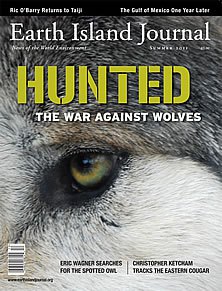
===
Top Photo: Courtesy Arizona Game and Fish
Kentucky wolf photos: Courtesy Earth First Newswire
Middle Photo: wolf/wolf hybrid Courtesy newsjournaldotcom
Red wolf photo: Courtesy Wiki
Horse photo: Courtesy Wiki
Bold Vision logo: Courtesy Bold Vision Conservation
Bottom Photo: Courtesy Earth Island Journal
Posted in: Wolf Wars, Endangered Species Act, biodiversity, Activism
Tags: Echo, “coyote excuse”, dispersing wolves poached, wolf recovery, USFWS, Congress, Utah, Kentucky, Missouri, Kansas, North Carolina, Illinois, North Carolina, Washington, Montana, Wyoming, Idaho, Wisconsin, Minnesota, Michigan, abusing the ESA, change needed, Bold Visions Conservation, Earth Island Journal

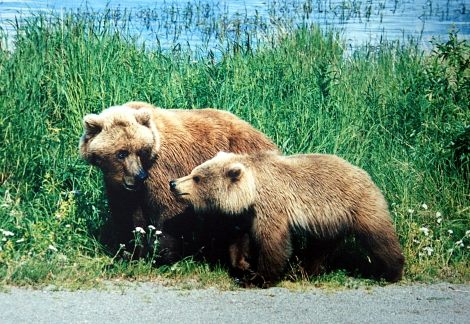
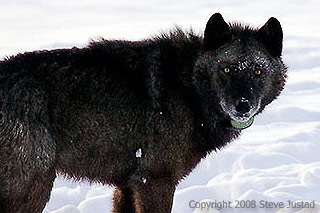


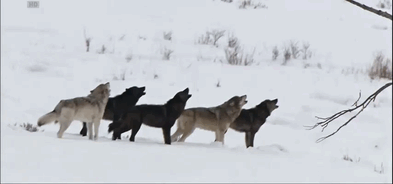

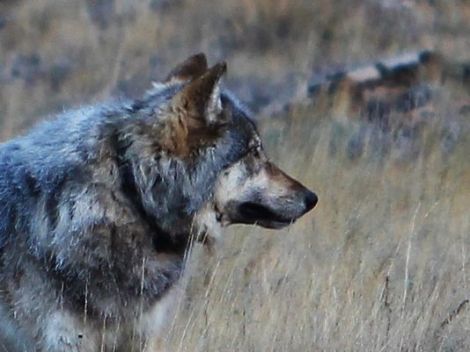










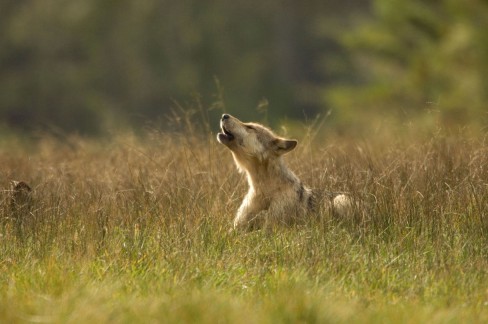

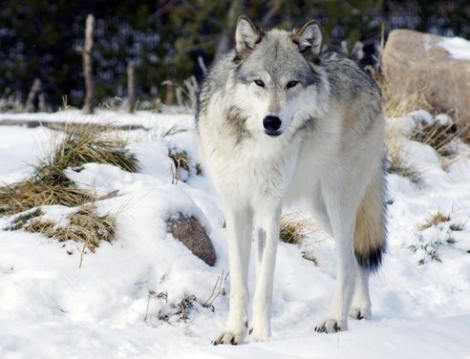








 Boulder White Clouds Council
Boulder White Clouds Council Exposing The Big Game
Exposing The Big Game Footloose Montana
Footloose Montana Friends of the Clearwater
Friends of the Clearwater Lockwood Animal Rescue Center
Lockwood Animal Rescue Center Louise du Toit
Louise du Toit LUPUSLAETUS
LUPUSLAETUS Mercy For Animals
Mercy For Animals Northern Idaho Wolf Alliance (NIWA)
Northern Idaho Wolf Alliance (NIWA) Predator Friendly®- Because Wildlife Matters
Predator Friendly®- Because Wildlife Matters Project Coyote
Project Coyote Project: Wolf
Project: Wolf The Nature Conservancy
The Nature Conservancy The Ravensong Group
The Ravensong Group WildEarth Guardians
WildEarth Guardians Wisconsin Wildlife Ethic-Vote Our Wildlife
Wisconsin Wildlife Ethic-Vote Our Wildlife Wolf And Wildlife Studies: Jay Mallonee (Independent Wolf Biologist)
Wolf And Wildlife Studies: Jay Mallonee (Independent Wolf Biologist) Wolf Song of Alaska
Wolf Song of Alaska Wolves in english ! Les loups en anglais !
Wolves in english ! Les loups en anglais ! WWP's Gray Wolf Page
WWP's Gray Wolf Page Yellowstone To Yukon Conservation Initiative
Yellowstone To Yukon Conservation Initiative
Embarrassing Press Coverage Continues For USFWS National Wolf Delisting Push…..
Wolf Pups Snoozing
February 26, 2014
USFWS continues to take heat over their politically transparent push to nationally delist gray wolves. They’ve never looked more inept or disingenuous as they attempt to twist the ESA into silly putty to suit their agenda.
PLEASE COMMENT!!!
Deadline Midnight March 27, 2014
http://www.regulations.gov/#!docketDetail;D=FWS-HQ-ES-2013-0073
===
Feds’ postponement of wolf delisting follows embarrassing scientific review
But if you’re inclined to believe, or even just to hope, that sound science still has a role in such decisions — well, this embarrassing episode may be worth a closer look. The picture you’ll see is not pretty.
It’s probably fair to say that wolves are by far the biggest headache that Fish and Wildlife has been handed under the Endangered Species Act. Wolves have had ESA protections for four decades now, and for more than half that time the service has been working actively to shed its responsibilities for these worshipped and detested predators, battling an assortment of national groups at every turn.
What looked like maybe the last of those turns came in June, when FWS announced its plan to end protection of gray wolves throughout the remainder of the lower 48 where authority hadn’t already been turned back to the states.
However, such delisting decisions are legally required to be rooted in the “best available science,” and here the service had a problem: Its primary foundation for this delisting was a single paper laying out a fairly controversial re-classification of wolf species.
One species or two?
That paper, by Steven M. Chambers and three others, came down squarely in favor of seeing North American gray wolves as being of two types:
Plenty of other wolf biologists and animal geneticists think that question is far from settled — and more than a few actually think it has been settled in the opposite direction of Chambers’ conclusion, with all gray wolves belonging to just one species.
The science of these things is complex and technical, as you might expect, rooted in DNA mapping and requiring judgments as to whether DNA differences detected among wolves are permanent or temporary, results of evolutionary divergence or interbreeding convergence, and so on.
But if the differences at the molecular level are tiny, at the policy level they could hardly be larger.
The gray wolf has Endangered Species Act protection until FWS can prove it’s no longer needed; “eastern gray wolves,” if they exist, have never been protected and presumably never will be, since virtually all of the territory that would be considered their natural range has been wolfless for a long, long time.
In another policy decision that has brought sharp criticism recently, FWS has chosen to define the “natural and historic range” of a threatened species as whatever territory it occupied at the time of being listed for protection — not its historic territory. Some critics see this as an effort to rewrite the ESA by recasting its most important definition.
In-house research project
There were some other problems with the Chambers paper, too:
FWS claimed at the time that it had no role in the picking and unpicking, but a reporter for MSN News turned up an email in which the three were told by the contractor that, “I understand how frustrating it must be, but we have to go with what the service wants.”
The only way out of the ensuing embarrassment was to halt that review and arrange for a second, this one to be undertaken by five scientists chosen without the service’s knowledge or involvement, and their work was released earlier this month.
It happens that one of the five, Robert Wayne of UCLA, was also among the three bounced from the first panel. But as the panel’s report puts it:
In any case, the five were assigned to give no thought to the policy aspects of the delisting proposed by FWS but to consider only its scientific basis for making them. And its conclusions are rather stark:
===
Photo: wolf-pups_mythwallpaper-com
Posted in: Wolf Wars, Endangered Species Act
Tags gray wolf, shaky science, USFWS, national wolf delisting proposal, please comment, March 27, 2014 deadline, wolf persecution
Share this:
- endangered species act
- Wolf Wars
on February 26, 2014 at 2:00 am Comments (17)Tags: 2014 deadline, gray wolf, March 27, national wolf delisting proposal, please comment, shaky science, USFWS, wolf persecution